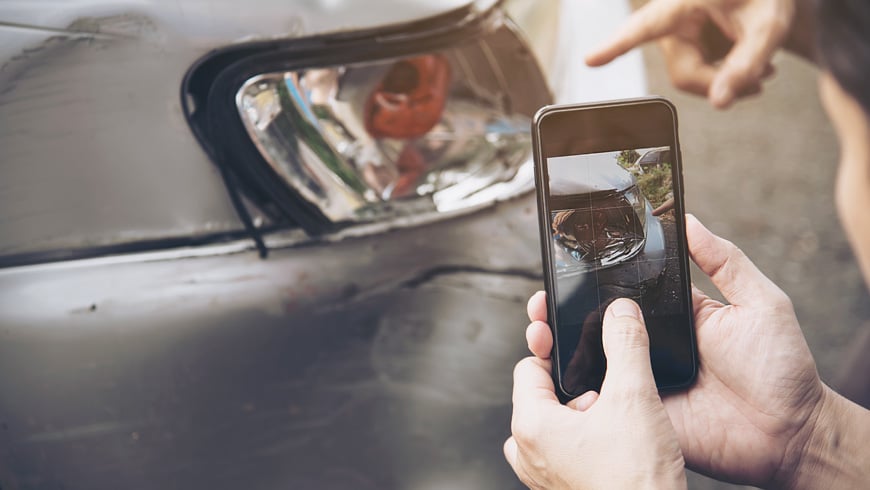Accidents happen. And when they do, knowing how to file a car insurance claim is crucial for getting your life back to normal.
Whether you’ve been in a fender-bender or your car has been damaged by a fallen tree, understanding the claims process can save you time, money, and stress.
Knowing beforehand what information your insurance company will require to process your claim will make the process go much smoother and speed up your claim.
Here are 5 steps that detail the insurance claim process.
Step 1: Safety First
Before anything else, ensure everyone’s safety. Have you been in an accident? Move to a safe location if possible. Are there injuries? Call 911 immediately.
Your well-being is paramount, so take care of yourself and others involved before worrying about insurance.
Many claims are not injury or even accident-related, such as damage from a hail storm or flooding, but in these cases, still keep your personal safety as your top priority. Wait for the weather to clear before worrying about any damage to your vehicle.
Step 2: Gather Information
Once safety is assured, it’s time to collect crucial details. What information do you need? Here’s a quick checklist:
- Names and contact information of all parties involved
- Insurance details of other drivers
- Vehicle information (make, model, license plate number)
- Location and time of the incident
- Photos of the damage and accident scene
- Contact information of any witnesses
Remember, the more information you gather, the smoother your claims process will be.
Don’t forget to jot down your own recollection of events while they’re fresh in your mind!
Even the most calm and collected driver can often forget to document crucial details that can be difficult to recollect after the fact.

Step 3: Contact Your Insurance Company
Now that you have all the necessary information, it’s time to notify your insurer.
Most insurance companies have multiple ways to initiate a claim: phone, mobile app, or website. Choose the method that’s most convenient for you and be prepared to provide the details you’ve gathered.
What does your policy say about reporting claims?
Your car insurance policy likely includes language about your responsibility to report claims. The verbiage in the policy will read something very similar to this:
“We must be notified promptly of how, when and where the accident or loss happened. Notice should also include the names and addresses of any injured persons and of any witnesses.”
Typically, insurance policies don’t provide an exact timeframe for what constitutes “prompt” notification. This deliberate vagueness allows for flexibility in various situations. However, it also puts the onus on the policyholder to act responsibly and quickly.
Best Practices for Policyholders
To ensure compliance with the “prompt notification” clause, policyholders should:
- Report the incident as soon as it’s safe to do so
- Aim to notify the insurer within 24-48 hours if possible
- Not delay reporting, even if all details aren’t immediately available
- Document reasons for any delay in reporting
Step 4: Work with Your Claims Adjuster
After you’ve reported the claim, an adjuster will be assigned to your case. They’ll guide you through the next steps, which may include:
- Reviewing your policy coverage
- Inspecting the damage to your vehicle
- Arranging for repairs or a rental car if covered
- Negotiating with other parties’ insurance companies if necessary
Be honest and thorough in your communications with the adjuster. Why? Because providing accurate information ensures a fair and efficient claims process.
The job of a claims adjuster is multifaceted and challenging. They serve as investigators, evaluators, negotiators, and customer service representatives.
Their work ensures that insurance claims are settled fairly and accurately, balancing the interests of both policyholders and insurance companies.

Step 5: Document Everything
Throughout the claims process, keep detailed records. Having accurate information of the incident and all correspondence with your insurance company is critical to making sure your claim is settled properly.
What should you document? Here’s a comprehensive list of items to track:
- Date, time, and location of the incident
- Names and contact information of all parties involved
- Police report number and officer’s name (if applicable)
- Photos of the damage and accident scene
- Witness statements and contact information
- All conversations with your insurance company, including:
- Date and time of each call or interaction
- Name and title of the person you spoke with
- Summary of what was discussed
- Any promises or commitments made
- Repair estimates from body shops or contractors
- Receipts for any emergency repairs
- Rental car receipts and agreements
- Medical bills and records related to injuries from the incident
- Lost wage documentation if you missed work due to the incident
- Towing or storage fees for your vehicle
- Any correspondence (emails, letters) with your insurance company or other parties
- Notes from in-person meetings with adjusters or appraisers
- Receipts for any out-of-pocket expenses related to the claim
- Timeline of events related to the claim process
These records can be invaluable if disputes arise or if you need to reference something later. By maintaining thorough documentation, you’re protecting your interests and ensuring a smoother claims process.
20 Things to Avoid When Filing a Car Insurance Claim
We laid out the five steps ensuring your claim experience is as positive as possible. But what about things you should not do?
Here’s a list of 20 things to avoid after a car accident:
- Don’t admit fault or apologize at the accident scene
- Don’t leave the scene of an accident without exchanging information
- Don’t forget to call the police, especially for serious accidents
- Don’t delay reporting the accident to your insurance company
- Don’t provide a recorded statement to the other driver’s insurance company without consulting your insurer or an attorney
- Don’t accept a settlement offer without fully understanding your damages and injuries
- Don’t sign any documents without reading and understanding them thoroughly
- Don’t forget to document the accident scene and damages
- Don’t dispose of or repair damaged property before the insurance company inspects it
- Don’t exaggerate your injuries or damages
- Don’t lie or provide false information to your insurance company
- Don’t post details about the accident on social media
- Don’t neglect to follow up with your insurance company if you haven’t heard back
- Don’t refuse medical treatment if you’re injured, even if the injuries seem minor
- Don’t forget to keep all receipts related to the accident and claim
- Don’t discuss fault with the other driver or witnesses
- Don’t lose your temper or become confrontational with other parties involved
- Don’t forget to get contact information from witnesses
- Don’t accept a check marked “final payment” unless you’re sure you’re ready to settle
- Don’t handle complex claims without considering professional help (like an attorney) if needed
If you follow the five steps in filing a claim, and also adhere to the list of twenty things to not do, you can pretty much guarantee that you’ll have a positive experience when filing a claim.
Common Questions and Scenarios
What if the accident wasn’t my fault?
Even if you believe you’re not at fault, it’s still important to inform your insurance company. They can help protect your interests and may work with the other party’s insurer to resolve the claim.
Determining fault is not always easy in an accident, and it’s important to file an accurate accident report that details the circumstances of the incident.
Insurance companies will use the accident report to help determine who was at fault in the accident, and consequentially which insurance coverage will pay for the damages.
Will filing a claim increase my premiums?
It depends on various factors, including the nature of the claim, your driving history, and your insurance company’s policies. Not all claims result in premium increases, but it’s a possibility you should be aware of.
Claims where you were determined to be at fault (especially liability claims) have more of a chance of impacting your rates than claims that you had no control over such as weather events or hitting a deer.
What if my car is totaled?
If the cost to repair your vehicle exceeds its value, it may be declared a total loss.
Damage is considered a total loss when the cost to repair your vehicle would exceed what it’s worth.
In this case, your insurer will typically offer you the actual cash value of your car. Your policy may state:
“Our limit of liability for loss will be the lesser of the:
1. Actual cash value of the stolen or damaged property; or
2. Amount necessary to repair or replace the property with other property of like kind and quality.”
Understanding this clause can help you navigate the claims process if your car is totaled.
Establishing the actual cash value of the vehicle can be sticky situation in a lot of claims. In some cases, the insured may feel their vehicle is worth more than the settlement amount offered by the insurance company.
In these cases, you can take matters into your own hands and research the value of similar vehicles. Present this data to your claim adjuster and make a valid argument as to why you feel your vehicle is worth more than their offer.
You may not always be able to get an increased settlement, but if the numbers you provide are reasonable, you stand a 100% better chance of receiving a better offer than if you did nothing at all.
Conclusion
Filing a car insurance claim can be streamlined by following the steps outlined, and thorough documentation is the key to achieving a good outcome.
Remember, your insurance company is there to help you through this process. Don’t hesitate to ask questions and seek clarification when needed. Stay informed, stay prepared, and drive safely!
 During his career as an independent insurance agent,
During his career as an independent insurance agent,